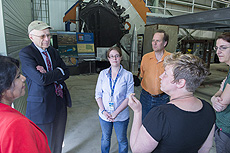William Colglazier: Science is a tool of diplomacy
 |
William Colglazier (left), science and technology adviser to the Secretary of State, tours the neutrino experimental area. Photo: Reidar Hahn
|
Editor's note: William Colglazier, science and technology adviser to the Secretary of State, gave a colloquium at Fermilab on May 21. In this Q&A, he offers his views of science, diplomacy and how one can serve the other in improving our world.
How does science fit into the State Department?
Science diplomacy is really important to the State Department. "Science diplomacy" is kind of the term we use for how science can be helpful to diplomacy, using science as a tool to advance diplomatic goals, but it's also diplomacy advancing the scientific enterprise.
Many international collaborations all have to have agreements with other countries, and the State Department is the key in helping negotiate that. It's also involved in advancing U.S. science by helping overcome problems such as with visa issues and other things where collaboration can be hindered by policies of governments.
It may be that scientists want to have access to some unique research environment that doesn't exist in the United States, for example in ecological areas. Diplomacy can be very useful in helping advance scientific goals.
There are a lot of people in the State Department that have scientific backgrounds, which has grown over the years. Being there for three years, I've learned that science is even more of an asset to diplomacy than I appreciated, and I was sympathetic to begin with. Other countries do want to engage with our government agencies, but often even more so with our universities, our national laboratories, and our companies.
How can science be used as a diplomatic tool?
Science is actually a great strategic asset for American diplomacy because other countries do want to engage with us. We're the world leader in science and technology. Engaging with countries using science as the tool, the connector, is a great way to influence their science, their behavior, their investments. I deal with a lot of countries now, and with every country I talk with, no matter the level of development, the first thing their governments want to talk about regarding science and technology is the connection to innovation and economic development.
You might say, "Does that make them tougher competitors if we help them get more capable?" But my view is that it's in the U.S. interest to have countries more knowledge-based, to use science as input into their policy decision. That's clearly in the U.S. interest.
In countries where the U.S. does not have diplomatic relations — Iran, Cuba — the State Department is very supportive of using mutually beneficial scientific cooperation to keep a channel of communication open. With the encouragement of the State Department, the U.S. National Academy of Sciences has been engaging in several workshops a year with the Iranian scientific community. And many of the Iranian delegations come under a great program with the State Department called International Visitor Leadership Program. So the State Department has actually provided some of the financial support to enable Iranian scientific delegations to meet in the U.S. with the U.S. National Academy of Sciences.
Read more
—Leah Hesla
View a video of Colglazier's colloquium talk.
|